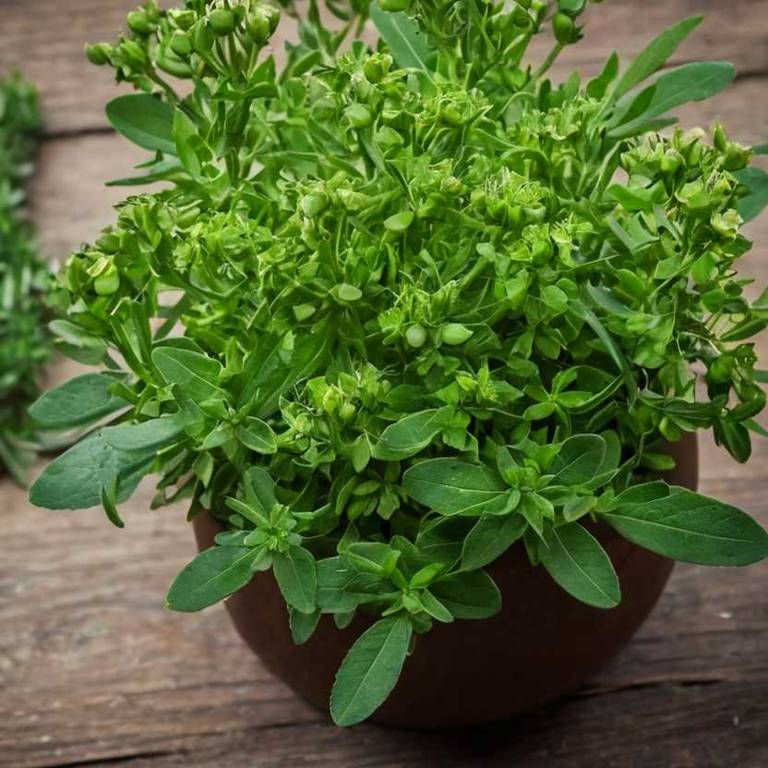By Leen Randell
Updated: Jul 06, 2024
What to know about Euphorbia esculenta (wild potato) before using it medicinally

Euphorbia esculenta, commonly known as wild potato, is a herb that has been revered for its numerous health benefits, which range from treating digestive issues to lowering blood pressure and cholesterol levels.
As a hardy and versatile herb, it is often cultivated for its edible tubers, which can be consumed raw or cooked, and for its ornamental value in gardens and landscapes. Botanically, Euphorbia esculenta is a succulent shrub belonging to the Euphorbiaceae family, characterized by its small, green leaves and woody stems.
Historically, this herb has been used by various cultures for centuries, including the traditional medicine of Africa and Asia, where it is still valued for its medicinal and culinary properties.
This article explains the medicinal, horticultural, botanical, and historical aspects of Euphorbia esculenta.
What are the medicinal properties of Euphorbia esculenta?
Euphorbia esculenta helps with various health issues, including diabetes, hypertension, and inflammatory conditions. It is also used to treat fever, rheumatism, and as a purgative. The plant's roots and tubers have been traditionally used for medicinal purposes.
The active constituents of Euphorbia esculenta include alkaloids, glycosides, and resins. These compounds are responsible for the plant's medicinal properties, which include anti-diabetic, anti-hypertensive, and anti-inflammatory activities. The plant's roots contain a high concentration of these active constituents.
The roots and tubers of Euphorbia esculenta are the most commonly used parts for medicinal purposes. They are rich in starch and contain a high concentration of active constituents. The roots are typically harvested during the dry season and dried for later use.
Improper use of Euphorbia esculenta can cause side effects such as stomach upset, diarrhea, and allergic reactions. In rare cases, the plant's toxic compounds can cause liver or kidney damage. Prolonged use can also lead to dependence and withdrawal symptoms.
Precautions when using Euphorbia esculenta medicinally include proper identification of the plant, dosage adjustment according to individual needs, and consultation with a healthcare professional. Pregnant or breastfeeding women should avoid using the plant, as well as individuals with certain medical conditions.
What are the horticulural aspects of Euphorbia esculenta?
Euphorbia esculenta grow in subtropical to tropical regions with warm temperatures between 15°C to 30°C. It prefers full sun to partial shade and well-draining sandy soils with a pH range of 6.0 to 7.0. It can thrive in poor soils but performs well in fertile ones.
Planting tips for Euphorbia esculenta involve sowing seeds 1-2 cm deep in spring or autumn, spacing them 10-20 cm apart. Water regularly during the first year, then reduce watering to once a week. Fertilize annually with a balanced fertilizer to promote healthy growth.
Harvesting tips for Euphorbia esculenta involve digging the tubers in autumn or winter, when the soil is dry. Carefully avoid damaging the tubers, which can be roasted, boiled, or dried for consumption. The tubers can be harvested after 6-9 months of growth, or when the tops of the plants begin to die back.
Common pests of Euphorbia esculenta include aphids, whiteflies, and spider mites, which can be controlled with insecticides. Fungal diseases such as root rot and leaf spot can be managed by improving soil drainage, removing infected tissues, and treating with fungicides.
What are the botanical aspects of Euphorbia esculenta?
Euphorbia esculenta is a succulent plant with thick, waxy stems and ovate leaves that are alternate and spirally arranged. The plant produces small, yellowish flowers in terminal cymes, which are followed by 3-seeded capsules.
Taxonomically, Euphorbia esculenta belongs to the family Euphorbiaceae, order Euphorbiales, and is a member of the genus Euphorbia, which comprises approximately 2,000 species. It is further classified as a species within the subgenus Chamaelobivia.
Several variants of Euphorbia esculenta exist, including the 'Tubers' variety, which is prized for its edible tubers, and the 'Spiny' variety, characterized by its dense, spiny stems. Other variants may be found with varying leaf shapes and sizes.
Euphorbia esculenta is native to the tropical regions of South Africa, Namibia, and parts of Mozambique. It has been naturalized in various other parts of Africa and has also been cultivated in some Asian and American countries.
The life cycle of Euphorbia esculenta begins with seed germination, followed by the development of a single stem that may produce adventitious tubers. After 6-12 months, the plant reaches maturity and produces flowers and seeds. The seeds may disperse through wind or animals, allowing the life cycle to repeat itself.
What are the historical aspects of Euphorbia esculenta?
Euphorbia esculenta is an ancient plant used for food, medicine, and dye by various cultures. Indigenous Australians used it as a starchy food source, while African and Asian cultures employed it as a medicinal herb. In some regions, its tubers were used for textile dyeing.
In ancient mythology, Euphorbia esculenta is associated with the fertility goddess, Pachamama, in Incan mythology. In Greek and Roman mythology, it was linked to the goddess of fertility, Demeter and Ceres respectively. Its association with fertility and abundance is widespread.
In various cultures, Euphorbia esculenta has been imbued with symbolic meanings. In Hinduism, it represents abundance and fertility, while in Africa, it is a symbol of good fortune and prosperity. In some indigenous cultures, it is considered a sacred plant.
Euphorbia esculenta is mentioned in various historical texts, including the Greek physician Dioscorides' De Materia Medica (circa 50-70 AD) and the Indian medical text, the Charaka Samhita (circa 400 AD). These texts attest to its use in traditional medicine.
Archaeological artifacts, such as ceramic vessels from ancient South Africa, depict Euphorbia esculenta in use for food and medicine. Fossil records show its presence in Africa dating back 8,000 years.